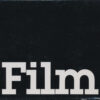Super8 and 16mm
I am happy you found this page. This lab sells super8, double8, ds8 and 16mm films.
Stories that you can’t get 8 and 16mm motion film any more are false. Many regular photo stores stopped selling super8 because the majority of the people use their mobile phone. So, everyone that is in love with film has come to the right place!
Kodak produces wonderful super8 films. And there are more companies that re-pack existing film (Kodak – Fuji – Orwo) or even manufacture their own emulsion.
Vision-3
Kodak made their new color negative emulsion Vision-3 series also available for super8 cartridges. This shows very clearly that the major company from Rochester USA believes that super8 is a valuable film format for the future. The Vision-3 50D, 200T and Vision-3 500T can be ordered with processing (and transfer) as the only lab in the Netherlands and one of the few in Europe.
You should be aware that in order to view the final results after processing colour negative films you must make a digital scan or a positive print from it, and you can not view the film after development with a movie projector.
If Kodak will ever introduce a new super8 camera is a big questionmark. It should bring super8 film making available for a whole new generation. We do have a new super8 Ektachrome 100 colour reversal which we started to sell since November 2018.
Film projection or digital files
Once your super8 has been processed with photochemistry you get the film on a reel. Reversal films like Kodak Tri-X and Kodak Ektachrome can be screened with a movie projector on the white wall, super8 as it intended to be. There is a big chance you might need a digital video file for editing and share online. This service is known as transfer, scanning or digitalizing. The S8RL offers a full service; you buy the cartridge including processing, and also the transfer from super8 to a digital file. Standard we offer a 2K full-frame or cropped QuickTime file ProRes 4.2.2 including a Mpeg4 version. Easy as that.
Which emulsion to choose
In general I would like to give some comment about film exposure. If you want a good result do not underexpose or overexpose super8 films. It is very difficult [not advised] to compensate the exposure mistakes during the processing of the films. Underexposed films get a higher contrast and overexposed films will get a lower contrast. In all situations you’ll get a different film look. For more on this subject visit the knowledge base pages.
If you ask the lab: What film should I use? The answer will be: That is a personal and technical choice you have to make. First check your camera manual to learn what film types it can automatically expose. If you don`t have a manual search for one on the internet. This info will limit your options. Secondly choose between black/white or colour films. And do you want a reversal film for projection or do you need a digital file anyway? This leaves you with a few options. Now how will your film look after exposure and processing (and maybe scanning)? The best way to learn the characters of all emulsions is to use them all at least once. I know this is an expensive road but understand what film makes so beautiful compared to digital files: every film emulsion and light situation gives you unique images!
Super8 notch
Discover if your camera can handle the type of emulsion you want to use by downloading and printing the Super8 Notch Ruler. It’s very handy, and advised if you got your first camera.


